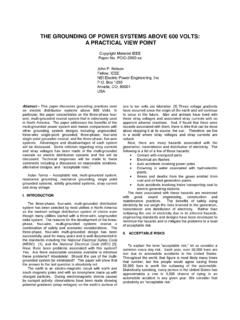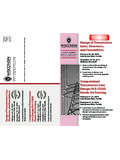Transcription of NATIONAL ELECTRIC SAFETY CODE (ANSI C2 / NESC)
1 NATIONAL ELECTRICSAFETY code (ANSI C2 / NESC) Jim TomaseskiIBEW Director of SAFETY and HealthNESC 2012 Executive Subcommittee approved final draft April 1, 2011 2012 Edition published on August 1, 2011 Effective January 1, 2012 NESCCOMMITTEE STRUCTURE Chairman and Vice Chairman Main Committee Executive Committee Interpretations Subcommittee Interim Amendment SubcommitteeSubcommittee 1 Purpose, Scope, Application, Definitions, and ReferenceSubcommittee 2 Grounding MethodsSubcommittee 3 ELECTRIC Supply StationsSubcommittee 4 Overhead Lines ClearancesSubcommittee 5 Overhead Lines Strength and LoadingSubcommittee 7 Underground LinesSubcommittee 8 Work RulesSection 1 Introduction (Scope, Purpose)
2 Section 2 DefinitionsSection 3 ReferencesSection 9 Grounding MethodsNESCNESC Part 1 Rules for the Installation of ELECTRIC Supply Stations and Equipment Part 2 SAFETY Rules for the Installation and Maintenance of Overhead ELECTRIC Supply and Communication Lines Part 3 SAFETY Rules for the Installation and Maintenance of Underground ELECTRIC Supply and Communication Lines Part 4 Work Rules for the Operation of ELECTRIC Supply and Communications Lines and Equipment Appendix A Uniform System of Clearances Appendix B -Uniform clearance calculations for conductors under ice and wind conditionsPart 4 Work Rules for the Operation of ELECTRIC Supply and Communications Lines and EquipmentSubcommittee 8 NESC (2007) SCOPE 011.
3 ScopeA. These rules cover supply and communication lines, equipment, and associated work practices employed by a public or private ELECTRIC supply, communications, railway, or similar utility in the exercise of its function as a utility. They cover similar systems under the control of qualified persons, such as those associated with an industrial complex or utility interactive The NESC covers utility facilities and functions up to the service : The NATIONAL Electrical code (NEC -NFPA 70, 2005 Edition) covers utilization wiring requirements beyond the service NESC rules cover street and area lights (supplied by underground or overhead conductors) under the exclusive control of utilities (including their authorized contractors) or other qualified persons (such as those associated with an industrial complex).
4 NOTE: Luminaires not under such exclusive control are governed by the requirements of the NESC rules do not cover installations in mines, ships, railway rolling equipment, aircraft, or automotive equipment, or utilization wiring except as covered in Parts 1 and (2007) SCOPENEC / NFPA -oldSection (B)(5):(5) Installations under the exclusive control of an ELECTRIC utility where such installationsa. Consist of service drops or service laterals, and associated metering, orb. Are located in legally established easements, rights-of-way, or by other agreementseither designated by or recognized by public service commissions, utility commissions, or other regulatory agencies having jurisdiction for such installations, orc.
5 Are on property owned or leased by the ELECTRIC utility for the purpose of communications, metering, generation, control, transformation, transmission, or distribution of ELECTRIC located in legally established easements, rights-of-way, or by other agreementseither designated by or recognized by public service commissions, utility commissions, or other regulatory agencies having jurisdiction for such installationsChanged (B)(5) to read as follows:(5) Installations under the exclusive control of an ELECTRIC utility where such installationsa. Consist of service drops or service laterals, and associated metering, orb.
6 Are on property owned or leased by the ELECTRIC utility for the purpose of communications, metering, generation, control, transformation, transmission, or distribution of ELECTRIC energy, orc. Are located in legally established easements or rights-of-way, ord. Are located by other written agreements either designated by or recognized by public service commissions, utility commissions, or other regulatory agencies having jurisdiction for such installations. These written agreements shall be limited to installations for the purpose of communications, metering, generation, control, transformation, transmission, or distribution of ELECTRIC energy where legally established easements or rights-of-way cannot be obtained.
7 These installations shall be limited to Federal Lands, Native American Reservations through the Department of the Interior Bureau of Indian Affairs, Military bases, lands controlled by port authorities and State agencies and departments, and lands owned by / NFPA -newThese installations shall be limited to Federal Lands, Native American Reservations through the Department of the Interior Bureau of Indian Affairs, Military bases, lands controlled by port authorities and State agencies and departments, and lands owned by 2012 Part 4 Complete review to clean up language 2 significant changes Rule on arc flash Rewrite to clarify intent Inclusion of <1000 volt exposures Minimum Approach Distances (MAD) Clean up Rule 441 Simplify MAD rulesWork Rules for the Operation of ELECTRIC Supply and Communications Lines and EquipmentNEW RULE Theemployershallensurethatanassessmentis performedtodeterminepotentialexposuretoa nelectricarcforemployeeswhoworkonorneare nergizedlines,parts,orequipment.
8 Iftheassessmentdeterminespotentialemploy eeexposure,clothingmadefromacetate,nylon ,polyester,orpolypropyleneshallnotbeworn ,unlessarcrated. Iftheassessmentdeterminesapotentialemplo yeeexposuregreaterthan2cal/cm2exists(see Neal,Bingham,andDoughty[B59]), ,oruseTable410-1,410-2,or410-3todetermin etheeffectivearcratingofclothingoracloth ingsystemtobewornbyemployeesworkingonorn earenergizedlines,parts,orequipmentatvol tages50 Vto800, ,thedurationofthearc(cycles), RULE Iftheassessmentdeterminesapotentialemplo yeeexposuregreaterthan2cal/cm2exists(see Neal,Bingham,andDoughty[B59]), RULE.
9 If the clothing or clothing system required by this rule has the potential to create additional or greater hazards than the possible exposure to the heat energy of the ELECTRIC arc, then clothing or a clothing system with an effective arc rating less than that required by the this rule may be 1: Assessments performed to determine potential exposure to an ELECTRIC arc consider the affected employee s assigned tasks and/or work 2: A clothing system (multiple layers) that includes an outer layer of flame resistant material and an inner layer of non-flame resistant natural fiber material has been shown to block more heat than a single layer.
10 The effect of the combination of these multiple layers may be referred to as the effective arc rating ( , EBT, ATPV).NOTE 3: Engineering controls can be utilized to reduce arc energy levels and work practices can be utilized to reduce exposure RULE 2012 Rule DOES RULE MEAN AND WHEN DOES IT APPLY?Interpretation requests (IR)asked these questionsNESC 2007 Rule (IR 557)While it is theoretically possible for an arc to occur whenever parts or equipment are energized, the likelihood in part is typically dependent upon the work being performed on energized facilities.





